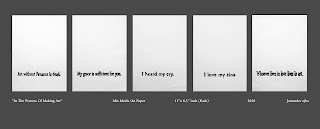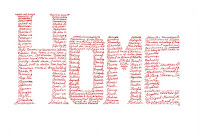TEXT AS TEXT II
The compulsion of reading textual works is found to be influential for all kind of scripts, with the reader trained to read the text or not. A logical mind is aware that the texts, unlike the visuals, have a relatively higher probability of correct interpretation of the message. Yet the diverse modes of linguistic constructs succeed in maintaining the barrier for direct communication.
The artists grouped together in the exhibition curated by Shubhalakshmi Shukla have congregated from various cities, with their individual responses to the curatorial concept of Pure Text as a point of entry for the viewers. The separation of retinal pleasure (of visuals) is a crucial element followed by most artists succeeding in a rendition of the textual-imagery invoking subtle yet unpoetic assimilations and metaphoric, direct, intriguing array of words striking the visual-readers.
Through an irregular display of works, quick surprises are sought as some works are minimal with a strong punch of socio-political critique, satire, and anecdotes. Perhaps the larger perception relays an insight to the positions of each artist responding to the ideas of ego, presence, inaccessibility, societal disparities, personal associations to city, land, neighbourhood, body, and gender. Perhaps this show is an extension of how art today is blurring the boundaries of different disciplines of arts viz. performing and plastic arts.
One observes Moutushi Chakravorty’s ‘Home Body Soil’ are the hand-written gestalt images comprised of existential dialogues explaining…immortality, vanity, building, breaking, urban-rural etc relevant to each encapsulating word of home, body, and soil. Mithu Joardar’s works titled ‘ID’ that reads Intra-dermal/ Inner Diameter are allegorical and bold in stating the sexual urge of the beings of pleasure principle and mutual exchanges. Nilesh Shilkars’comment on the violence within oneself has an exciting tactility provoking the viewer of the need to shun the violence within.
 |
| Work by Moutushi Chakravorty |
The sentences ‘Art without Penance is Dead,’ ‘My grace is sufficient for you,’ by Jeetandar Ojha are subtle, yet intriguing, offering a sense of compatibility and equation. The idea of grace hints at the Gandhian peace movement provoking far-reaching action. Roul Hemanta’s simple handwritten lines on the wall are easy yet satirical pointing to the major banking frauds that have occurred in the recent past of our country. The lines interestingly state ‘Apply lime to the Bank walls, jump over the wall’ (बैंक के दीवार में चुना लगाएं । दीवार के ऊपर छलांग लगाएं।). They incite an amusement of a rural smart humour.
Less emphasized facts of city life where our neighbours are shadows, and we all stay under the same water tank formulates the works highlighting the unobserved by Yashwant Deshmukh. An interesting twist to the show is the inclusion of Marathi rappers’ troupe comprising Mayur and Yugal Waikar, Ankit Hachekar, Ashok Kadam, and Pranav Rajput with their rapping critiquing, a sympathizer of the downtrodden, underdogs and taking a stand against the governmental enactments.
We rely on the medium of textual review to stray into the actual works in anticipation of reducing the communication barrier for an afterlife to the dialogue of the ephemeral nature of words.
The exhibition was held at Gallery Art and Soul, Mumbai
Images provided by the curator
--------------------------
About: Nikhil Purohit is an artist and a pedagogue working in arts management, writing, arts documentation and archiving. He is also the editor of India Art Journal.
Please share this article using the social media widgets at the bottom and do subscribe to receive regular updates from Art Scene India.
To contribute articles, please get in touch at artsceneinfo@gmail.com
- 5 Reasons a Good Catalogue Text is Essential for Your Art
- How To Write An Artist Statement
- 6 Tips On How To Approach An Art Gallery And Find Gallery Representation
- Exhibiting Art in Non-Gallery Spaces













